CT
Computed Tomography
CT – Computed Tomography – is the name given to the process of generating 2-D and 3-D cross-sectional images of an object from flat X-ray images. CT works by taking digital radiographic images at a large number of positions around 180° of the circumference of a component. By a process si milar to triangulation, the features generating the density changes on the radiographs can be positioned within the cross-section of the component. To generate a 3-D image, a number of such cross-sections are produced and stacked on top of each other.
milar to triangulation, the features generating the density changes on the radiographs can be positioned within the cross-section of the component. To generate a 3-D image, a number of such cross-sections are produced and stacked on top of each other.
 milar to triangulation, the features generating the density changes on the radiographs can be positioned within the cross-section of the component. To generate a 3-D image, a number of such cross-sections are produced and stacked on top of each other.
milar to triangulation, the features generating the density changes on the radiographs can be positioned within the cross-section of the component. To generate a 3-D image, a number of such cross-sections are produced and stacked on top of each other.CT can generate 3-D images of cracks within the component under inspection and can be a better alternative to destructive examination. However, the component under test must be small enough to be accommodated by the particular CT equipment and be fully penetrated by the X-ray energies used by that CT system.
The Figure shows a 3-D tomographic reconstruction of a crack (courtesy of KANDE International Ltd).
For more information on CT see:
http://www.ndt-validation.com/technologies/pr_3.jsp?menu_pos=0
and
http://www.ndt-ed.org/EducationResources/CommunityCollege/Radiography/AdvancedTechniques/computedtomography.htm
What the hec?! articles are not intended to be the definitive account on the topic or acronym in question. Readers’ comments and contributions are welcomed. Email: ndtnews@bindt.org